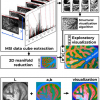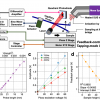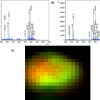Researchers have used mass spectrometry imaging to uncover exactly how a human egg captures an incoming sperm to begin the fertilisation process, in a new study published this week in Science (doi: 10.1126/science.1207438). The research identifies the sugar molecule that makes the outer coat of the egg “sticky”, which is vital for enabling the sperm and egg to bind together. Researchers across the world have been trying to understand what performs this task for over 30 years.
The scientists behind this study believe their work could help address some of the previously unexplained causes of human infertility and sub-fertility and be very useful for diagnosing this problem in couples who are unable to have children. It could also provide a new target for the development of natural contraceptive agents. The international team, from the University of Missouri, the University of Hong Kong, Academia Sinica in Taiwan and Imperial College London, discovered that the sugar chain known as the sialyl-lewis-x sequence (SLeX) is highly abundant on the surface of the human egg. After experimenting with a range of synthesised sugars in the laboratory they went on to show that SLeX specifically binds sperm to an egg, and tested their findings using the outer coats of unfertilised 'non-living' human eggs.
“This exciting research is providing the first insights into the molecular events occurring at the very beginning of human life. The details we've discovered here fill in a huge gap in our knowledge of fertility and we hope they will ultimately help many of those people who currently cannot conceive,” said Professor Anne Dell CBE FRS FMedSci from the Department of Life Sciences at Imperial College London, who led the team that discovered the SLeX sugars on the egg surface.
“Unravelling the composition of the sugar coat that shrouds the human egg is the culmination of many years of painstaking research by my mass spectrometry colleagues at Imperial. This endeavour was an enormously difficult task because human eggs are very tiny—about the size of a full stop—so we didn't have much material to work with.”
The World Health Organisation estimates that infertility affects up to 15% of reproductive-aged couples worldwide and almost one in every seven couples in the UK have problems conceiving a child for various clinical reasons, many of which are still unexplained by medical science.
Lead author, Dr Poh-Choo Pang, also from the Department of Life Sciences at Imperial College London, said: “We hope that our study will open up new possibilities for understanding and addressing the fertility problems that many couples face. Although clinical treatments are still a way off, we are very excited about the new research into fertility that we hope will now be possible, building on our work.”
“We first proposed a model of human sperm-binding involving SLeX-like molecules on the outer covering of the human egg in 1992. Our recent studies have now confirmed that this longstanding model is correct,” said corresponding author and associate professor Gary Clark, from the University of Missouri School of Medicine. “Defining how the sperm initially recognises and then penetrates the egg's sugar coat is important for the design of natural contraceptive agents and for unravelling causes of previously unexplained human infertility or sub-fertility.”
A sperm “recognises” an egg when proteins on the head of the sperm meet and match a series of specific sugars in the egg's outer coat. Once a successful match has been made, the outside surfaces of the sperm and egg bind together before they merge and the sperm delivers its DNA to the inside, fertilising the egg.
The authors of this new study used ultra-sensitive mass-spectrometric imaging technology to assess which molecules were most likely to be key in the binding process. They discovered that SLeX is abundantly found on the egg's outer coat and that it is expressed at a much higher concentration than any of the other sugars that can be found on the thick transparent shell. From these results, they deduced that SLeX was most likely to be responsible for binding with proteins on the head of the sperm.
The research team in Hong Kong tested whether SLeX was the key binding sugar using the outer coats of unfertilised and non-living human eggs, obtained by informed consent from in vitro fertilisation patients. They carefully bisected the empty coat in a delicate procedure using a tiny knife, carried out under a powerful microscope. The scientists treated one half with a chemical that prevented the SLeX sugar from binding, to see what effect this would have on a sperm’s ability to bind to the egg. When they released sperm around the bisected egg, they found that significantly fewer bound to the treated half of the egg coat than the untreated half.
“Our knowledge on sperm-egg binding in humans is limited. The identification of SLeX would enable researchers to uncover other molecules involved in this important process of human life,” said Professor William Yeung from the Department of Obstetrics and Gyneacology and the Centre for Reproduction, Development and Growth at the University of Hong Kong, who led this phase of the research.
The researchers are now keen to use the findings of this study to further investigate the proteins on the head of a sperm that enable it to recognise an egg.




